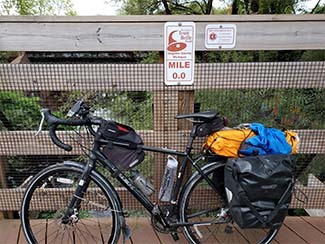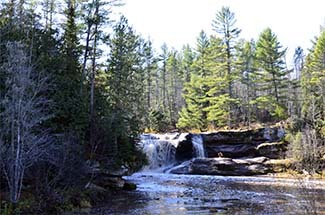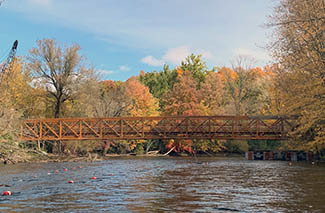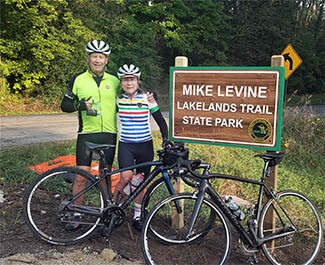The path forward – developing Michigan’s signature Iron Belle Trail
By DOUG DONNELLY
Michigan Department of Natural Resources

Momentum that has been building over the past couple of years to develop Michigan’s Iron Belle Trail – The Trail State’s roughly 2,000-mile centerpiece trail system – continued to gain steam over the summer months as nearly 30 miles of the route were completed.
“The Iron Belle Trail continues to be a shining example for trails in Michigan,” said Paul Yauk, state trails coordinator with the Michigan Department of Natural Resources’ Parks and Recreation Division. “Through partnerships, collaborations and trail champions across the state, the trail has truly come alive the last couple of years. The planning that was done two and three years ago is now leading to construction projects across Michigan.”
The trail touches hundreds of cities, towns and smaller communities as it winds through 48 of Michigan’s 83 counties. Using existing trails, networks and new connections, the trail extends more than 2,000 miles from Ironwood, at the far western tip of the Upper Peninsula, to Belle Isle Park in Detroit. The trail includes two separate routes – one a designated hiking route and the other a designated bicycle trail.
The concept to develop a signature trail – to help showcase Michigan as The Trails State – was announced by former Gov. Rick Snyder at an economic conference in 2012.
In his message on “Ensuring Our Future: Energy and the Environment,” Snyder said Michigan has more total trail miles than just about any other state, The Mining Journal reported.
“Much of the credit goes to volunteers who have shoveled, raked, trimmed and groom these trails on their own time and often at their own expense,” Snyder said. “This shows the real appetite Michiganders have for quality trails and points to the opportunity we have to be the No. 1 trail state.”
Since then, the DNR has worked to build partnerships and to leverage state and federal dollars against private funds to continue to develop the Iron Belle routes.
|

This past summer, new connections were celebrated in Jackson County, where 13 miles of the trail were developed, and near Gaylord, where 13 miles were built, extending the North Central State Trail to a length of nearly 75 miles.
“I see users on that trail every single day,” said Rachel Frisch, Otsego County administrator. “It really is a testament to how excited the community is, not only for our residents but also for tourists that come into our area.”
New trail segments also were dedicated in Washtenaw County by the Huron Waterloo Pathways Initiative, along with projects announced in a dozen other counties.
“Where you really see the magic of it is when you look at the individual pieces,” said Jeff Hardcastle, HWPI board chairman. “Within the trail system, those individual pieces often are the neighborhoods, communities and schools.”
Earlier this month, a mile-long segment of trail near the Wayne-Washtenaw county line was opened in southeast Michigan. The extension was a small piece of trail in the big picture, but another important connection, paid for with a combination of public and private funding.
“Our supporters want to be part of the Iron Belle Trail,” said Susan Faulkner, executive director of the HWPI. “They are making these investments locally.”
From 2015-2019, the DNR has awarded nearly $8 million in Iron Belle Trail grants for various projects, many of which have been completed or are nearing completion. The funds come from multiple sources and have leveraged more than $12 million in matching funds from local, federal and private sources.
Projects like completion of the O Kun de Kun Falls trail, which is part of the North Country National Scenic Trail and the Iron Belle Trail, were funded through a collaboration of local, state and federal partners.
More than a mile of trail to the falls was improved to raised gravel, with boardwalks constructed over wet and muddy areas, funded through nearly $250,000 in grant money from the Iron Belle Trail and Michigan Natural Resources Trust funds.
|

A celebration of the completion of those trail improvements was held Oct. 26 at the falls route trailhead in Ontonagon County.
Attendees included U.S. Rep. Jack Bergman, who praised the efforts of all involved to get the work completed cooperatively. He also discussed the importance of getting outdoors.
“This is about the physical health, but also the mental health it spawns from the physical exertion and the sounds of the falls behind us and the smell of the woods here in the fall,” Bergman said. “This is who we are as human beings."
Thirteen new miles of the Mike Levine Lakelands Trail State Park in Jackson County, which is part of the Iron Belle Trail, opened this fall. In fact, the inaugural Great Lake-to-Lake Route No. 1 ride in September used the route as part of the event’s journey from South Haven to Port Huron.
Improvements on the Iron Belle Trail are also taking place in Detroit.
Projects such as construction of a new trailhead at Belle Isle Park are being spurred, in part, by private contributions from the Ralph C. Wilson Jr. Foundation.
Earlier this month, dozens of people gathered in the southwest part of the Motor City to celebrate the groundbreaking of the Fort Street Interpretive Park, a new park at the foot of the Fort Street Bridge. The park will serve as an interpretive park for the Rouge River, as well as a park commemorating the Hunger March of the 1930s, a significant historical event.
“This new park connects us to our industrial past, automotive history – and serving as a hub – linking Detroit to the Iron Belle Trail, the Downriver Linked Greenways and the Lower Rouge Water Trail,” said Maureen McCormick, executive director of the Friends of the Rouge.
This summer, metro Detroit resident Ken Martinek embarked on a 14-day, 900-mile journey on the Iron Belle Trail, riding from the far northwest iron ore and copper country in the Upper Peninsula, along the shores of Lake Michigan and Lake Huron, into the northern Lower Peninsula and, eventually, to Belle Isle Park.
|

“You start in Ironwood and ride through a beautiful, wildflower-filled linear park to Bessemer,” Martinek said. “There are Iron Bell Trail signs pointing the way. Then, you go past Lake Michigan and across the Mackinac Bridge, until you find yourself 600 miles down the road, riding through the dune-grass-covered rolling hills of Alabaster Arboretum. Now you’re looking at scenic views of Lake Huron. One trail – practically un-interrupted – for hundreds of miles.
“Whether it was a deer dancing down a tree-lined road and leaping off into the forest, or a windswept vista along the Lake Michigan shoreline, there was a beautiful surprise around every turn.”
Martinek said the beauty of the Iron Belle Trail is how it connects so many places to each other.
“I’ve lived in Michigan most of my life and I’ve been all over the state,” he said. “But the Iron Belle Trail took me to places I’ve never been before, places I didn’t even know about – beautiful places I’d have never seen from a car.”
Martinek said the Iron Belle Trail connects people as well as places, like a canoe trip outfitter he met in Watersmeet, in the western Upper Peninsula.
“He gave me a brief rundown on the history of Michigan’s copper country, covering the last 10,000 years,” Martinek said. “Then, on the far east side of the Lower Peninsula in Oscoda, (I met) a guy who just happened to know all about the history of the Au Sable River area. They were like next door neighbors, only 400 miles apart.”
For more information on the Iron Belle Trail, including an interactive map, visit Michigan.gov/IronBelle.
|
Check out previous Showcasing the DNR stories in our archive at Michigan.gov/DNRStories. To subscribe to upcoming Showcasing articles, sign up for free email delivery at Michigan.gov/DNR.
/Note to editors: Contact: John Pepin, Showcasing the DNR series editor, 906-226-1352. Accompanying photos and a text-only version of this story are available below for download. Caption information follows. Credit Michigan Department of Natural Resources, unless otherwise noted.
Text-only version of this story.
Bridge: This pedestrian bridge was installed this month over the Huron River in Washtenaw County, which has been home to multiple projects involving Iron Belle Trail routes this past summer. The bridge is located between Dexter-Huron Metropark and Zeeb Road.
Dingell: U.S. Congresswoman Debbie Dingell, center, attended an Iron Belle Trail announcement in May that included Paul Yauk (left), state trail coordinator for the Michigan Department of Natural Resources’ Parks and Recreation Division, and James (J.J.) Tighe, director of the Parks and Trails Initiative with the Ralph C. Wilson Jr. Foundation. The Wilson Foundation announced it was giving $100 million toward parks and trails projects in southeast Michigan, including several projects along the Iron Belle Trail.
Ecorse: The Iron Belle Trail helps connect much of the Downriver area, south of Detroit, including this park along the Detroit River in the city of Ecorse.
Falls: The Baltimore River plunges over a rock ledge at O Kun de Kun Falls in Ontonagon County. This is one of many beautiful sights to be seen along Michigan’s Iron Belle Trail.
Hikers-1 and Hikers-2: Iron Bell Trail hikers enjoy the recently completed improvements on the route near O Kun de Kun Falls in Ontonagon County. Funds for the trail upgrade were provided by sources including the Iron Belle Trail and Michigan Natural Resources Trust funds.
Levine: This summer, the first Great Lake-to-Lake Route No. 1 ride was held from South Haven to Port Huron. Part of that route was on a newly paved section of the Mike Levine Lakelands Trail State Park in southeast Michigan, which also is part of the Iron Belle Trail.
Scouts: For each of the past five years, the Michigan Department of Natural Resources has held the Iron Belle Challenge on National Trails Day, encouraging scouts of all ages to walk portions of the Iron Belle Trail. The scouts combined have walked more than 35,000 miles on Michigan trails.
Sign: Ken Martinek’s photo from the Iron Belle Trail route in a largely rural area near Saginaw.
Zero: Ken Martinek’s photo of the northern terminus of the Iron Belle Trail at the Michigan-Wisconsin state line in Gogebic County./
|